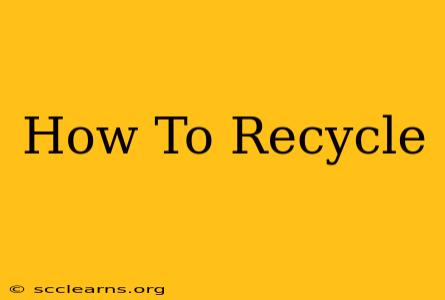Recycling is more than just throwing things in a blue bin; it's a crucial step towards environmental sustainability. This comprehensive guide will walk you through the process, clarifying common misconceptions and empowering you to make a real difference. Let's dive in and learn how to recycle effectively.
Understanding the Recycling Process
Before we get into the specifics of what to recycle, it's important to understand the journey your discarded materials take. The process generally involves these key steps:
- Collection: This is where you, the consumer, play a vital role. Properly sorting and placing your recyclables in designated bins is the first step.
- Processing: At a Materials Recovery Facility (MRF), your recyclables are sorted, cleaned, and processed. This often involves sophisticated machinery to separate different materials.
- Manufacturing: The processed materials are then used to create new products, completing the recycling loop.
What Can You Recycle?
This is often the most confusing part. The accepted materials vary depending on your local recycling program. Check your local guidelines! However, some common recyclables include:
Plastics
- #1 and #2 plastics: Look for these numbers inside the recycling symbol. These usually include plastic bottles and jugs.
- Some food containers: Check the label to see if they're recyclable in your area.
Important Note: Many plastics, such as #3-#7, are not widely recycled and should be avoided when possible. Opt for reusable alternatives whenever feasible.
Paper and Cardboard
- Newspaper: Flatten it to save space.
- Magazines: Remove any plastic wrapping.
- Cardboard boxes: Flatten them completely.
- Paper bags: Many are recyclable, but again, check your local guidelines.
Glass
- Glass bottles and jars: Rinse them out thoroughly.
- Broken glass: Some communities have specific guidelines for this; check your local waste management website.
Metal
- Aluminum cans: Crush them to save space.
- Steel and tin cans: Rinse them and remove any labels.
Other Recyclables
Some programs also accept items like:
- Cartons: Milk cartons, juice boxes, etc.
- Plastic bags: These usually require separate drop-off locations at grocery stores or recycling centers.
What NOT to Recycle
Contamination is a major issue in recycling. Here are some common items that should never go in your recycling bin:
- Food waste: This contaminates other recyclables and attracts pests.
- Dirty containers: Rinse out containers before recycling to prevent contamination.
- Plastic bags (unless specified): These often jam sorting machinery.
- Styrofoam: This is rarely recyclable.
- Electronics: These require special e-waste recycling programs.
- Diapers: These should go in the trash.
Tips for Effective Recycling
- Rinse and clean: Clean containers to avoid contamination.
- Remove lids: Separate lids from containers.
- Flatten items: Flatten cardboard and crush cans to save space.
- Check your local guidelines: Recycling rules vary by location.
- Support businesses with sustainable practices: Choose products with minimal packaging and made from recycled materials.
Beyond the Bin: Reducing Your Waste
Recycling is a crucial step, but it's only part of the solution. Reducing your consumption and reusing items are even more effective ways to minimize your environmental impact. Consider:
- Buying in bulk: Reduces packaging waste.
- Using reusable bags, water bottles, and coffee cups: Cuts down on single-use plastics.
- Composting food scraps: Reduces landfill waste and creates nutrient-rich soil.
By following these guidelines and making conscious choices, you can significantly reduce your environmental footprint and contribute to a healthier planet. Remember that even small actions can make a big difference! Let’s all work together to build a more sustainable future.

